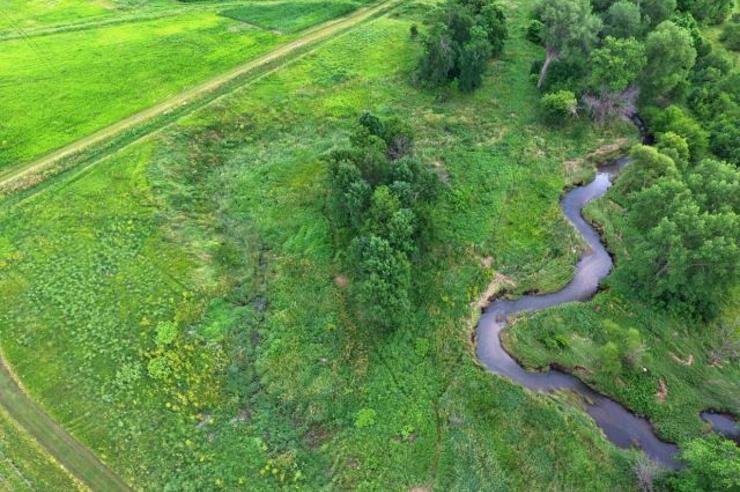Vinton defining flood resilience

There’s no question that the residents of Vinton, Iowa, are resilient. The community along the Cedar River has experienced flooding periodically over its 170-year history, including two major floods already in the 21st century. Each time, the community pulls together and moves on.
But how do you define resiliency?
“Does resiliency mean bouncing back to a former state exactly how it was before?” says Paul Schmitt. “Or should we rethink resiliency to mean making changes that make us stronger, our neighbors stronger, our community stronger?”
It is this broader story of flood resiliency—the ability to mitigate, prepare for, respond to, and recover from a flood—that the University of Iowa PhD student in English spent the summer and early fall learning about as it pertained to Vinton.
Community flood resilience refers to the relative ability of people living in a common watershed to plan and act collectively, using local capacities, to mitigate, prepare for, respond to, and recover from a flood.
The Iowa Watershed Approach Flood Resilience Program focuses on nine watersheds: Clear Creek, English River, Upper Iowa River, Middle Cedar River, Upper Wapsipinicon River, Dubuque/Bee Branch Creek, North Raccoon River, and East and West Nishnabotna Rivers.
The goals of the Flood Resilience Program are to:
- Measure, visualize, and communicate flood resilience resources,
- Enhance flood resilience content in formal watershed plans, and
- Improve social resources of flood resilience.
Through an internship with the Iowa Valley Resource Conservation and Development funded by UI’s Obermann Center for Advanced Studies’ Humanities for the Public Good initiative, Schmitt worked with the Iowa Watershed Approach’s Flood Resilience Program and UI’s Iowa Flood Center (IFC) in the town of about 5,000.
The IWA Flood Resilience Program, which focuses on nine Iowa watersheds, seeks to engage and empower community residents through listening to their stories, discussing current and potential efforts to prevent and respond to flood events, establishing partnerships, and developing tools that increase flood resiliency.
“Flood resiliency is most often evaluated or measured by looking at infrastructure, economics, or ecological changes,” says Jessica Rilling, executive director of Iowa Valley Resource Conservation and Development. “There is a growing interest at a national level as well as a state level to better understand the human element. The future will bring more severe rain events, and many of our Iowa communities are located on rivers. I’d like for people to think proactively about adapting not just for economic reasons but because the human impact is real. It’s harder to quantify, but just as real.”
In July, Schmitt helped coordinate and lead three community-engagement events. During two community conversations, residents were invited to share their flooding experiences—including photos and personal memorabilia—and discuss what flood resiliency means to them and their thoughts on how the community could evolve to become more resilient.
Schmitt says he was grateful to residents who shared their experiences. Many recounted the help they received from family and friends. Others spoke about how the stress of a flooding event exacerbated existing health concerns. One family’s story particularly illustrated the resourcefulness of Vinton’s residents.

“One woman was gracious enough to allow me to visit her farm that is on a low-lying property on the Cedar River,” Schmitt says. “As we walked around the farm, she shared her story of the 2008 flood, during which she and her husband kept 38 head of cattle on their front deck and out of harm’s way. They had to boat back and forth from town to their farm after evacuating, and fed the cattle for a week with hay they stored up in the kitchen beforehand. She was proud of their ingenuity and resilience.”
Community members also were invited to play a flood resiliency role-playing game developed by the National Academy of Sciences and adapted by JEO Consulting Group to make it more applicable for rural communities. Vinton marked the first time the adapted game was played with a group of residents who were not already specialists in emergency management.
Each participant is given a role, such as a homeowner, first responder, business owner, or local or state government officer. Working in groups, residents must make decisions based on their resources and responsibilities.
During two major floods this century—2008 and 2016—the community of Vinton has shown its commitment to resilience. The Flood Resilient Vinton website is meant to serve as a resource for residents to prepare for future flooding and other disasters, as well as share stories and stay engaged.
“I was a public health official, so my group had to decide how many ambulances we needed, how many two-way radios, fire trucks, et cetera,” Schmitt says. “Every group negotiates to decide what’s most important. Then the groups come together to tackle a challenge, such as whether you let the historic downtown flood or let a research lab flood. It makes you think about compromises, communication, knowing what resources are available. It also makes you recognize the really tough decisions that are made at various levels.”
Along with getting to know Vinton residents through these public events, Schmitt also went door-to-door to gather their stories.
“We wanted firsthand experiences and feelings about what it means to go through a flood, but we know flood events are traumatic,” Schmitt says. “It’s understandable that not everyone wants to talk about their experiences at a public meeting; it calls back a lot of emotions.”
Along with listening to residents’ stories, Schmitt also spent time learning about Vinton’s unique situation: its existing infrastructure and its geographical location, sitting in a basin on the Cedar River and between Mud Creek and Hinkle Creek, which flow into the Cedar.
Schmitt took everything he learned and created story maps that reflected the residents’ and community’s experiences for a new website: Flood Resilient Vinton. In one story map, viewers can slide a bar across the community, illustrating vulnerabilities on one side and resiliencies on the other.
The side to the left of the bar shows the 100- and 500-year floodplains and details vulnerabilities in the town, such as the Vinton Municipal Electric Utility and Vinton Fire Department being located next to the river and culverts acting as a choke point for stormwater flowing to the Cedar.
The side to the right of the bar outlines community resiliencies, such as plans to relocate emergency services away from flood-prone areas and strategic land-use practices that have been implemented around town. It also includes the forming of the Benton County Disaster Recovery Coalition, which prepares for future disasters, keeps preparedness in the forefront of Benton County residents’ minds, and, following disaster events, assists county residents as they recover.
The University of Iowa in fall 2018 received a four-year, $1,341,000 grant from the Andrew W. Mellon Foundation to support the Obermann Center for Advanced Studies’ creation of a degree in the Graduate College in collaboration with humanities departments that choose to participate. The grant includes funding for postdoctoral fellows, graduate interns, faculty development opportunities, visiting scholars, travel to conferences, and co-learning opportunities for students, staff, faculty members, alumni, and community partners.
Another story map takes a historical look at flooding in Vinton, including residents’ recollections of contemporary flooding events. Along with Schmitt’s two story maps, the website includes resources for flood information, preparedness, and recovery.
“I hope these tools help Vinton residents learn more about their local watershed and their situation, as well as navigate the difficulties of flood recovery,” Schmitt says. “I also hope we foster open lines of communication between residents and officials to help officials understand what people went through and residents understand how and why some decisions were made.”
The Vinton flood resiliency project is one of the first that the IFC and IWA plan to do in other Iowa communities. Schmitt and Rilling hope the work they accomplished can serve as a model for future initiatives, as well as be improved upon.
“The process has been as valuable as the final product,” Rilling says. “There really isn’t a blueprint for this type of effort yet, but there are a lot of ideas. We worked to fit an approach to Vinton, which has a population of about 5,000, that would feel genuine and worthwhile to the residents. I think our work was successful because we did some things that were simple but thoughtful.”
Environmental issues have long interested Schmitt. His doctoral research focuses on the entwinement of agriculture and literary form in post-1945 American literature. And as part of a class he took in urban and regional planning, he worked with a group to research and propose a comprehensive park-adaptation plan for Iowa City’s 152-acre Terry Trueblood Recreation Area. The Iowa Department of Natural Resources in fall 2019 awarded Iowa City $200,000 to begin implementing the group’s recommendations.
Schmitt says his background in the humanities served him well in Vinton.
“This project has helped me recognize how well the skills we gain in humanities PhD programs can transfer to jobs outside academia,” Schmitt says. “It got me thinking more seriously about nonacademic jobs, jobs with nonprofit organizations, community organizing, and community engagement. I also don’t see it as an ‘either-or’ decision where you have to commit to being a professor or not. It should be a flexible interplay between those realms.”
Schmitt recommends students take at least one class that involves a community-engagement project or get involved with community organizations.
“I really enjoy these projects because they get me out of the office and allow me to talk to community members and learn from them,” Schmitt says.
The Sebeka, Minnesota, resident also had another reason for enjoying his work in Vinton.
“Coming from a small town, that was meaningful for me as well.”



